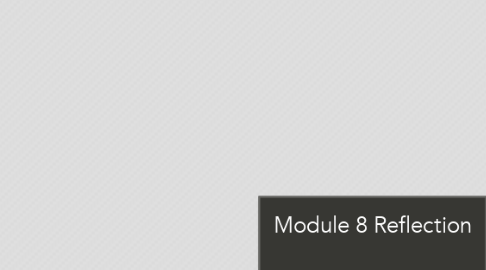
1. Facilitating Student Learning
1.1. Strengths
1.1.1. Promote, support, and model creative and innovative thinking and inventiveness
1.1.2. Engage students in exploring real-world issues and solving authentic problems using digital tools and resources
1.1.3. Promote student reflection using collaborative tools to reveal and clarify students’ conceptual understanding and thinking, planning, and creative processes
1.2. Needs
1.2.1. Model collaborative knowledge construction by engaging in learning with students, colleagues, and others in face-to-face and virtual environments
1.3. Action Plan
1.3.1. Establish a more collaborative environment where students meet online and virtually with experts in their field
2. Model digital age work and learning
2.1. Strengths
2.1.1. Demonstrate fluency in technology systems and the transfer of current knowledge to new technologies and situations
2.1.2. Collaborate with students, peers, parents, and community members using digital tools and resources to support student success and innovation
2.1.3. Model and facilitate effective use of current and emerging digital tools to locate, analyze, evaluate, and use information resources to support research and learning
2.2. Needs
2.2.1. Communicate relevant information and ideas effectively to students, parents, and peers using a variety of digital age media and formats
2.3. Action Plan
2.3.1. Create an interactive website where students can access up to the minute work and class activities.
2.3.2. Create an easy to navigate parent section where they can email me with questions or concerns.
3. Engage in professional growth and leadership
3.1. Strengths
3.1.1. Participate in local and global learning communities to explore creative applications of technology to improve student learning
3.1.2. Exhibit leadership by demonstrating a vision of technology infusion, participating in shared decision making and community building, and developing the leadership and technology skills of others
3.1.3. Evaluate and reflect on current research and professional practice on a regular basis to make effective use of existing and emerging digital tools and resources in support of student learning
3.1.4. Contribute to the effectiveness, vitality, and self- renewal of the teaching profession and of their school and community
3.2. Needs
3.3. Action Plan
3.3.1. Continue participating in professional development as it applies to current teaching schedule.
3.3.2. Continue offering technology support to others as needed.
4. Design and develop digital age learning experiences and assessments
4.1. Strengths
4.1.1. Design or adapt relevant learning experiences that incorporate digital tools and resources to promote student learning and creativity
4.1.2. Develop technology-enriched learning environments that enable all students to pursue their individual curiosities and become active participants in setting their own educational goals, managing their own learning, and assessing their own progress
4.2. Needs
4.2.1. Customize and personalize learning activities to address students’ diverse learning styles, working strategies, and abilities using digital tools and resources
4.2.2. Provide students with multiple and varied formative and summative assessments aligned with content and technology standards, and use resulting data to inform learning and teaching
4.3. Action Plan
4.3.1. Create a menu of activities that support differentiated learning and allow students to self-select their level of learning.
4.3.2. Create a systematic method of assessing student prior knowledge.
4.3.3. Create a systematic method of assessing student learning.
5. Promote and model digital citizenship and responsibility
5.1. Strengths
5.1.1. Advocate, model, and teach safe, legal, and ethical use of digital information and technology, including respect for copyright, intellectual property, and the appropriate documentation of sources
5.1.2. Address the diverse needs of all learners by using learner-centered strategies providing equitable access to appropriate digital tools and resources
5.1.3. Promote and model digital etiquette and responsible social interactions related to the use of technology and information
5.2. Needs
5.2.1. Develop and model cultural understanding and global awareness by engaging with colleagues and students of other cultures using digital age communication and collaboration tools
5.3. Action Plan
5.3.1. Attend as many professional development trainings as possible around cultural understand and global awareness.
5.3.2. Continue to have crucial conversations with my site admin about cultural understanding.
6. Essential Conditions
6.1. Strengths
6.1.1. Shared Vision
6.1.2. Empowered Leaders
6.1.3. Consistent and Adequate Funding
6.1.4. Equitable Access
6.1.5. Skilled Personnel
6.1.6. Technical Support
6.1.7. Student-Centered Learning
6.1.8. Support Policies
6.1.9. Supportive External Context
6.2. Needs
6.2.1. Implementation Planning
6.2.2. Ongoing Professional Learning
6.2.3. Curriculum Framework
6.2.4. Assessment and Evaluation
6.2.5. Engaged Communities
6.3. Action Plan
6.3.1. Development of a cohesive and technology integrated STEAM program for my site
6.3.2. Development of a skills inventory to monitor student acquisition of skills.
6.3.3. Development of pre/post assessments to monitor student achievement toward the acquisition of technology skills
